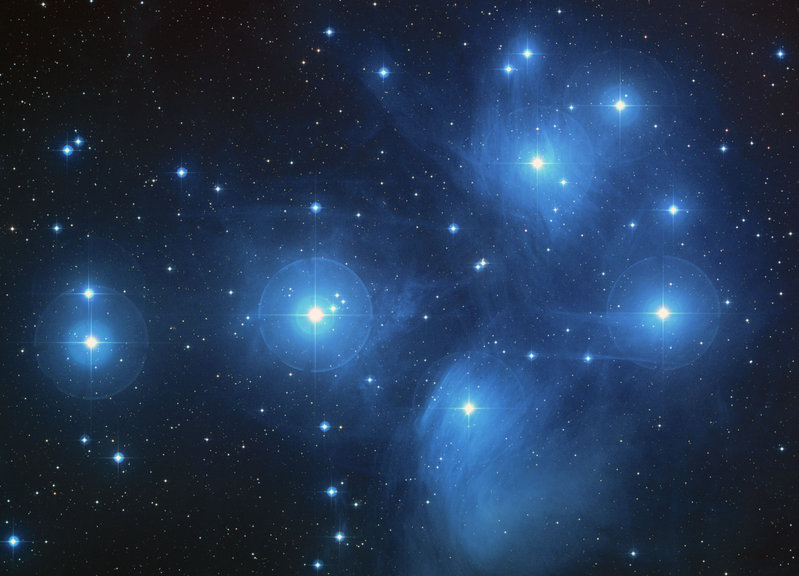
i heard a story from greek mythology when i was growing up, that the great hunter, orion, fancied all 7 of the pleiads sisters, but was forbidden to court any of them by zeus. to prevent the courtship, zeus transformed the sisters into birds and sent them off to the heavens. when orion died, zeus placed him behind the seven sisters in the sky to eternalize his chase. i have since seen a couple variations of this story and who knows if my memory is actually what i heard!
 this image is from a maori theatre group
this image is from a maori theatre groupthe pleiades star cluster contains over 1000 stars! All these stars formed from the same big cloud of gas, about 100 million years ago. now, they are all gravitationally bound together, orbiting around each other. the cluster is about 400 light years away from earth, and it's only 13 light years across.
now... onto the pretty pictures! i really like this picture that i found at the orbiting frog blog showing M45 in various wavelengths of light, from top left to bottom right... radio, microwave, near-infrared, visible, ultraviolet and x-ray.

the small green squares in the bottom right image from the orbiting ROSAT satellite show the locations of the brightest blue stars we see with our eyes and the hubble space telescope (HST). next is a more detailed image from HST showing optical light. the bright vertical and horizontal lines coming out of the brightest stars are called diffraction spikes and result from light bouncing off the internal structure of the telescope.

you can also think about this as youre gazing up at the pleiades star cluster... astronomers just announced the discovery of planet embryos colliding together within the cluster! this is a tough event to actually observe, so these are very exciting results!
below is a color composite image of the pleiades star cluster by Inseok Song of the Spitzer Science Center. the image was created by combining images from different types of optical wavelengths... blue, green and red images. the location of the star, HD 23514, with the orbiting planetesimals, is shown by the yellow arrow. the inset artwork is by Lynette Cook for Gemini Observatory.

read more at universe today.
2 comments:
Pretty pictures showing Pleiades! The tale of Seven Sisters is fascinating as is the story about Semjase who is said to come from Pleiades. Google gives (Semjase) almost 50 000 sites,
an example http://semjasebluestar.tripod.com
My Brothers wherever you are,Travellers in Time hear me now,Day will come they'll open thier eyes to see the Diamand Pleiads...
Post a Comment